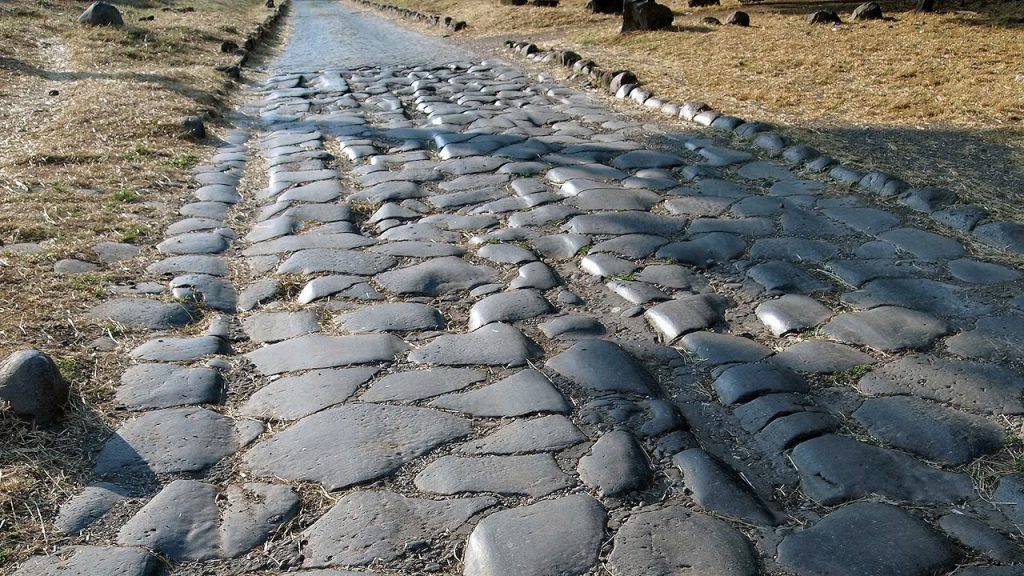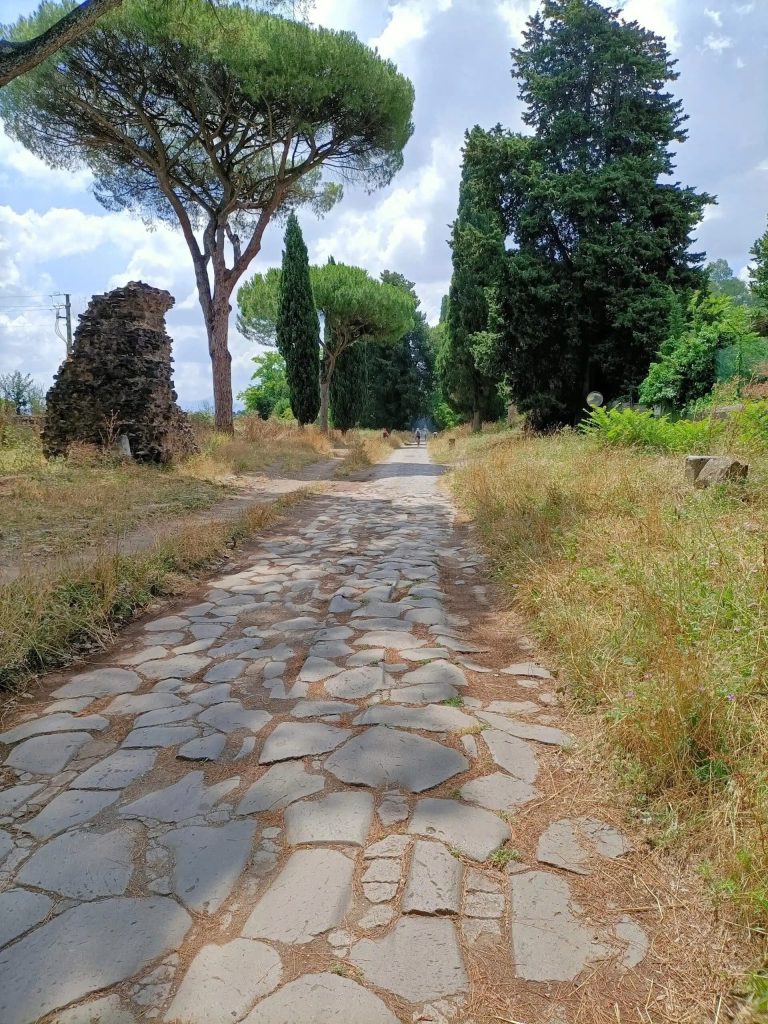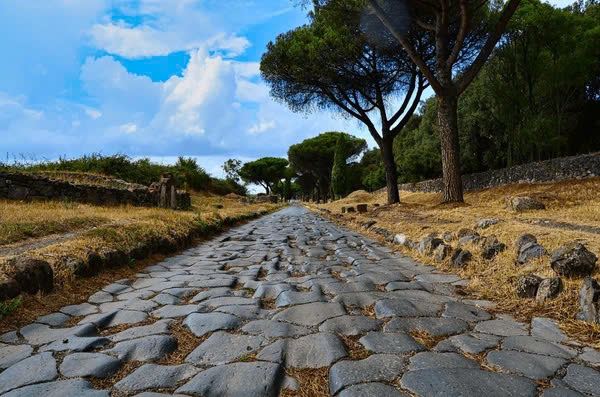The story of the Appian Way is a testament to Roman ingenuity and ambition that continues to inspire us today. Built in 312 BC under the oversight of Roman censor Appius Claudius Caecus, this extraordinary road stretched over 660 kilometers, connecting Rome to the southernmost reaches of Italy. It stands as a monumental achievement that demonstrates how infrastructure can shape the course of history and civilization.

When the Romans first began laying the stones of the Appian Way, their primary goal was to achieve military supremacy. During the Samnite Wars, this road became their secret weapon, enabling legions to move swiftly and strategically across Italy. Initially conceived as a military pathway to secure dominance, the Appian Way quickly evolved into something much greater, influencing commerce, culture, and connectivity.
The construction of the Appian Way showcased the Romans’ advanced engineering skills. Workers meticulously layered stone, gravel, and sand to create a surface so durable that parts of it still exist today. The process began with deep trenches filled with foundational stones, followed by layers of smaller rocks and gravel. Finally, the road was topped with basalt stones, perfectly fitted to form a smooth yet enduring surface. This ingenious design provided a road sturdy enough to endure centuries of use and smooth enough to support chariot travel. This combination of durability and functionality was unprecedented and set a new standard for infrastructure in the ancient world.

As Rome’s influence expanded, so did the purpose of the Appian Way. What started as a military route became a bustling artery of commerce and cultural exchange. Merchants traveled its length, carrying goods such as wine, olive oil, and grain to and from Rome. By reaching the port city of Brindisi, the road connected the capital to the broader Mediterranean world, facilitating trade with Greece, Egypt, and other distant regions. This transformation elevated the road from a tool of war to a vital component of Rome’s economic and cultural dominance.
The Appian Way was also a symbol of imperial power. The famous saying “All roads lead to Rome” found its most fitting representation in this highway. Beyond its practical applications, the road served as a stage for emperors and generals to showcase their victories. Triumphal processions highlighted Rome’s strength, reminding both citizens and foreign visitors of the empire’s grandeur. The Appian Way became an enduring emblem of Roman authority, binding together the vast empire through its masterful engineering and connecting its people through commerce and culture.
Today, portions of the Appian Way still stand as a remarkable testament to Roman innovation. Its construction marked the beginning of an extensive network of roads that would eventually span 322,000 kilometers, becoming the backbone of the Roman Empire. These roads facilitated not only the movement of armies but also the exchange of goods, ideas, and traditions, enabling the empire to thrive for centuries. The Appian Way was more than just a road; it was a lifeline that linked the ancient world and paved the way for enduring prosperity.
This ancient highway remains a powerful reminder of the vision and skill of its creators. The Romans built not only for their present needs but also for generations to come. The durability of the Appian Way speaks volumes about their foresight and commitment to excellence. It stands as an archaeological marvel and a symbol of human achievement, highlighting how infrastructure can influence the destiny of civilizations.
The legacy of the Appian Way endures because it is a story not just of stones and mortar but of human ingenuity. It represents the ability to conceive and execute projects that change the course of history. From its origins as a military pathway to its evolution into a cultural and economic lifeline, the Appian Way continues to captivate the imagination of people worldwide. Its enduring presence is a testament to the fact that some achievements truly withstand the test of time.

The Appian Way teaches us that infrastructure is more than mere utility; it is a statement of human ambition and creativity. The Romans understood that roads could connect not only places but also people, ideas, and economies. By investing in such a monumental project, they demonstrated their belief in the power of connectivity to foster growth and unity. The road’s impact extended far beyond its original purpose, influencing the development of Europe and leaving a legacy that continues to shape the modern world.
As we walk along the remaining stretches of the Appian Way today, we are reminded of the incredible vision of the ancient Romans. Their ability to blend practicality with grandeur created a road that was both functional and symbolic. It was a pathway for armies, a conduit for commerce, and a stage for power. The Appian Way became an integral part of Roman identity, reflecting their values of strength, innovation, and connection.

Modern infrastructure projects can draw inspiration from the Appian Way. Its longevity underscores the importance of quality and foresight in construction. The Romans’ meticulous attention to detail ensured that their work would endure, benefiting not only their contemporaries but also future generations. Today, as we build roads, bridges, and other infrastructure, the example of the Appian Way reminds us to think not just about immediate needs but about the long-term impact of our creations.
The story of the Appian Way is a narrative of ambition, resilience, and ingenuity. It reflects the best of what humanity can achieve when driven by a vision that extends beyond the present. By looking back at this extraordinary achievement, we gain insight into the values and priorities of the ancient world and find lessons that are still relevant today. The Appian Way is more than a relic of the past; it is a beacon of what is possible when we strive for greatness.

In the end, the Appian Way isn’t just about the road itself. It’s about the ideas and aspirations it represents. It’s about the determination to build something lasting and meaningful, something that connects and empowers. From its military beginnings to its role as a cultural and economic artery, the Appian Way stands as a timeless reminder of the power of human ingenuity to create lasting change.





